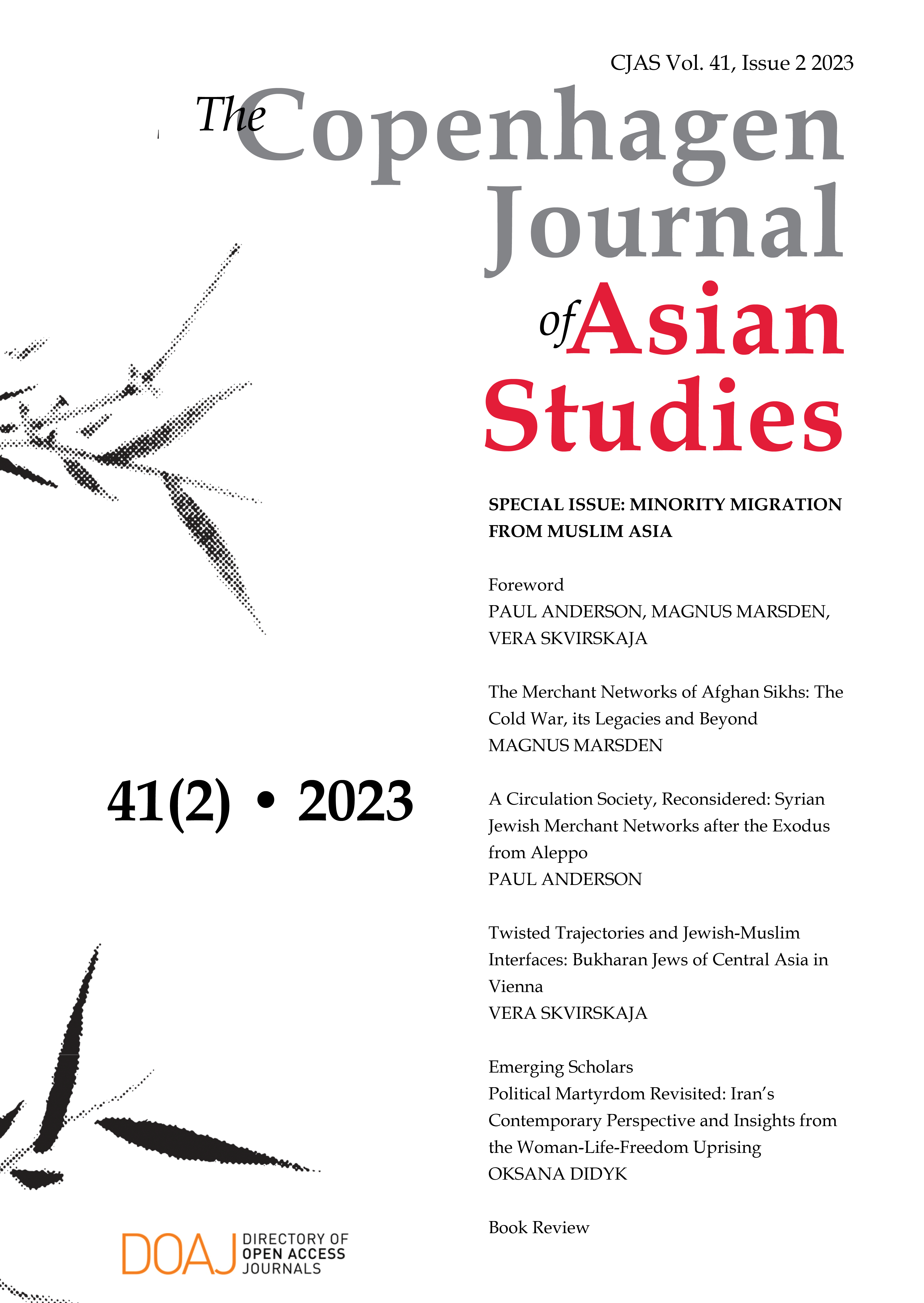A Circulation Society, Reconsidered: Syrian Jewish Merchant Networks after the Exodus from Aleppo
DOI:
https://doi.org/10.22439/cjas.v41i2.7106Keywords:
Syria, Jews, trading networks, Milan, Kobe, São PauloAbstract
This article analyses the durability of transregional Syrian Jewish merchant networks through the twentieth and early twenty-first centuries, when the centre of these trading networks shifted several times in response to economic transformations and political pressures. Migration patterns from Aleppo following the Ottoman collapse and the exodus after 1947 call for a modified conceptualisation of centres, peripheries and circulation from dominant approaches to merchant networks and circulation societies. Centres are generally thought of as the origin points of persons and goods – namely, women, religious specialists and collateral-free credit – which circulate exclusively within the network; peripheries are nodes which merely receive and depend on centres in these respects. I add to this by analysing central or critical nodes as those where different kinds of mobility intersected to inject new vitality into the networks. Peripheries are not only dependent nodes, but vital points of refuge and transition in times of duress. Furthermore, beyond persons and credit, the circulation of aesthetic and ethical standards, in addition to name values, has helped to maintain the integrity of the network in a period of geographic reconfiguration.
References
Aslanian, Sebouh David 2014. From the Indian Ocean to the Mediterranean: The Global Trade Networks of Armenian Merchants from New Julfa. Berkeley: University of California Press.
Bonacich, Edna 1973. 'A Theory of Middleman Minorities'. American Sociological Review 38 (5): 583-594. https://doi.org/10.2307/2094409
Choueke, Ezra 2021. Womb of Diamonds: A True Adventure from Children Bridge of Syria to Celebrity Businesswoman of Japan. Ezra Choueke.
Clarence-Smith, William 2004. 'Middle Eastern Migrants in the Philippines: Entrepreneurs and Cultural Brokers'. Asian Journal of Social Science 32 (3): 425-457. https://doi.org/10.1163/1568531043584827
Collins, Lydia and Morris Bierbrier 2006. The Sephardim of Manchester: Pedigrees and Pioneers. Manchester: Shaare Hayim, the Sephardi Congregation of South Manchester.
Curtin, Philip 1984. Cross-cultural Trade in World History. Cambridge: Cambridge University Press. https://doi.org/10.1017/CBO9780511661198
Gross, Daniel 2022. A Banker's Journey: How Edmond J. Safra Built a Global Financial Empire. New York: Radius Book Group.
Harel, Yaron 1998. 'The First Jews from Aleppo in Manchester: New Documentary Evidence'. AJS Review 23 (2): 191-202. https://doi.org/10.1017/S0364009400010436
Ho, Engseng 2017. 'Inter-Asian Concepts for Mobile Societies'. The Journal of Asian Studies 76 (4): 907-928. https://doi.org/10.1017/S0021911817000900
Laskier, Michael and Reeva Simon 2002. 'Economic Life'. In R. Simon, M. Laskier and S. Reguer (eds) The Jews of the Middle East and North Africa in Modern Times. New York: Columbia University Press, pp. 29-48.
Marcus, Abraham 1989. The Middle East on the Eve of Modernity: Aleppo in the Eighteenth Century. New York: Columbia University Press.
Markovits, Claude 2000. The Global World of Indian Merchants, 1750-1947: Traders of Sind from Bukhara to Panama (Vol. 6). Cambridge: Cambridge University Press. https://doi.org/10.1017/CBO9780511497407
Marsden, Magnus 2021. Beyond the Silk Roads: Trade, Geopolitics and Mobility across Eurasia. Cambridge: Cambridge University Press. https://doi.org/10.1017/9781108974387
Milkewitz, Alberto 1991. The Jewish Community of Sao Paulo, Brazil. Jerusalem: Jerusalem Center for Public Affairs.
Munn, Nancy 1992. The Fame of Gawa: A Symbolic Study of Value Transformation in a Massim (Papua New Guinea) Society. Durham, NC: Duke University Press.
Roffe, Sarina 2006. An Analysis of Brooklyn's Rabbinical Takana Prohibiting Syrian and Near Eastern Jews from Marrying Converts. MPhil Thesis. New York: Touro College.
Rossetto, Piera 2022. 'Mind the Map: Charting Unexplored Territories of In-visible Migrations from North Africa and the Middle East to Italy'. Jewish Culture and History 23 (2): 172-195. https://doi.org/10.1080/1462169X.2022.2062840
Shelemay, Kay Kaufman 1998. Let Jasmine Rain Down: Song and Remembrance among Syrian Jews. Chicago: University of Chicago Press.
Sutton, Joseph 1979. Magic Carpet: Aleppo-in-Flatbush: The Story of a Unique Ethnic Jewish Community. New York: Thayer-Jacoby.
Sutton, Joseph 1988. Aleppo Chronicles: The Story of the Unique Sephardeem of the Ancient Near East, in Their Own Words. New York: Thayer-Jacoby.
Sutton, Claudette 2014. Farewell, Aleppo: My Father, My People and their Long Journey Home. Santa Fe, New Mexico: Terra Nova Books.
Levi, Tomer 2012. The Jews of Beirut: the Rise of a Levantine Community, 1860s-1930s. New York: Peter Lang. https://doi.org/10.3726/978-1-4539-0235-6
Zuntz, Ann-Cristin 2023. 'Human Routers'. Cultural Anthropology 38 (4): 517-540. https://doi.org/10.14506/ca38.4.04
Zenner, Walter 2000. A Global Community: The Jews from Aleppo, Syria. Detroit: Wayne State University Press.
Downloads
Published
Issue
Section
License
Copyright (c) 2024 Paul Anderson

This work is licensed under a Creative Commons Attribution 4.0 International License.


